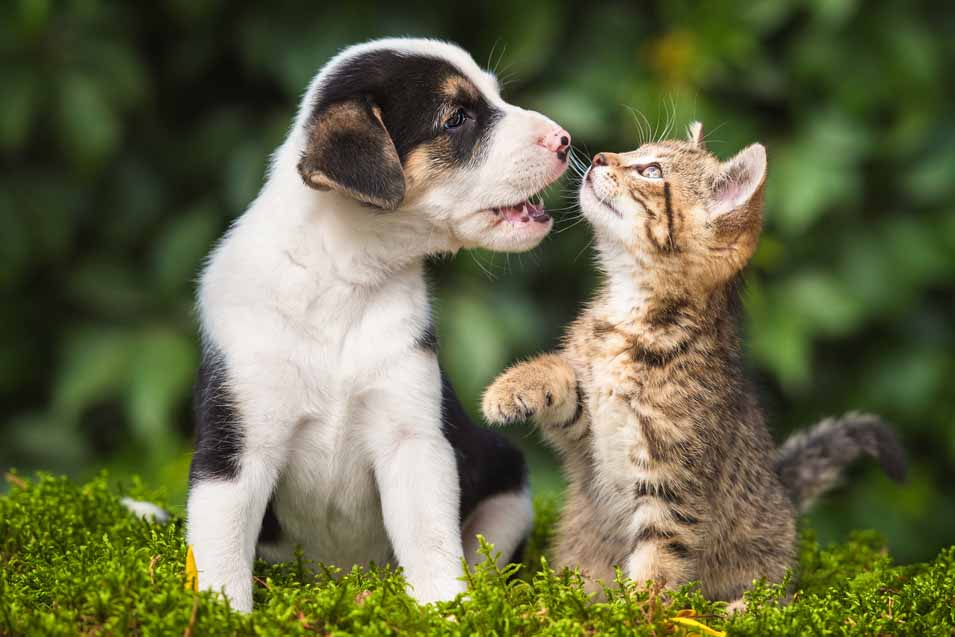Since time immemorial, it seems cats and dogs have been mortal enemies. Though some cats and dogs are able to co-habit peacefully, it seems a larger percentage prefer to occupy completely separate spaces altogether. What is it that has our two favorite pet species so determined to remain at odds with each other?
Perhaps it’s a battle for resources with neither side wiling to concede defeat. After all, when a mother’s love and tasty food are involved, it’s hard to walk away and let the other “man” win. If you are the proud owner of both a cat and a dog, you may wonder if it’s possible for your two favorite furry friends to live together in peace and harmony.
An Ancient Conflict
The truth is the battle between cats and dogs is ages old. It traces its roots back to their very origins as meat-eating animals. Since both cats and dogs prefer a diet rich in protein, they were natural opponents in the battle to procure an ample food supply in the wild. Since desperate times call for desperate measures, our beloved feline and canine friends sometimes had to resort to fighting and killing one another when their survival depended upon it. Though today our modern pets have no need to engage in a no holds barred fight to the death for their next meal, the intensity that fuelled it still remains painfully alive in them.
In fact, cats and dogs don’t feel any natural affection or aversion to one another. As far as their species go, they are much more practically minded, preferring to not engage with the other unless out of absolute necessity. What they really feel is indifference. There were far easier food sources for the wild cat and dog, meaning there was little need for them to ever interact.
Man has taken these two species, domesticated them, and decided that they should dwell together. Unfortunately, no one thought to consult cats and dogs before undertaking this major decision. And the bottom line is it all feels quite foreign to them, and neither species likes it very much.
Taking any animal out of their natural environment leads to confusion, and an animal that is out of their element is bound to act differently. Stress often leads to behaviors never before evidenced in our pets. Since dogs and cats are creatures of habit who thrive under routine, they don’t respond well to change. This can often lead to conflict in an otherwise calm and peaceful home.
Cats are Not Dogs, and Dogs are Not Cats
Different species view life entirely differently, and this “worldview” shapes how animals conduct themselves. Dogs, by nature, are social animals. Their natural curiosity and desire to please propels them into the front and center position of every activity. This is diametrically opposed to the nature of the cat whose inclinations are to remain wary and aloof. Because these two species approach the same situation very differently, communication misfires are likely to happen, and when they do, conflict ensues.
Of particular trouble is the cat’s natural propensity to flee situations that make them uncomfortable. Many breeds of dogs love to chase, and others also are hardwired with an exceedingly high prey drive whose genetic compulsions initiate the chase sequence at the first sight of an animal taking off at top speed. The cat does not appreciate being chased, and the dog cannot help but follow his natural instincts to pursue, and even attack and sometimes kill, what he views as prey. It’s not intentional; it’s instinctive. What starts out as a game in the dog’s eyes becomes a true battle because of the cat’s perception of the chase as a real threat. But these two instincts, one to flee and the other to chase, are at the heart of why cats and dogs struggle to cohabit together in harmony. They are hardwired for different purposes, and those purposes are continually at odds with one another. When viewed from a historical position, this all makes perfect sense. Each species is practicing precisely what they would have needed to do in the wild to survive. We may have brought the cat and dog into our living rooms, but we will never erase centuries of innate programming that has been bred into cats and dogs since the very first ones roamed the earth.
Still, domesticated dogs and cats have adapted to home living remarkably well. Though not all cats and dogs get along, many do.
What You Can Do if Your Cat and Dog Don’t Get Along
If you’re one of the unlucky ones with a cat and dog bound on killing each other and wrecking your home in the process, you are likely wondering if there is anything you can do to help your two favorite furry friends to learn to get along. Both cats and dogs are highly intelligent, and therefore, trainable.
If your cat and dog are waging WWIII in the middle of your living room, here are some things that you can do to help build a friendship between the unlikely pair:
Rein in the dog
Most conflicts arise because your dog’s behavior is seen as “pushy” by your cat. By taking time to tether your dog to you and reward calm behavior, you can help reduce his overwhelming enthusiasm thus naturally reducing conflict between Fido and his feline pal.
Reduce togetherness
Absence makes the heart grow fonder, and while your cat may never yearn for the company of your dog, it is possible to reduce friction by strictly limiting the amount of time they spend together while you work on training them to see each other in a more favorable light.
Reinforce good behavior
When your cat and your dog are able to be in each other’s presence without chasing or attacking one another, be certain to reward them richly for it. You want your cat and dog to associate each other with good things happening. If Fido starts to see that calmly lying beside Frisky equals a cookie, you are far more likely to see the behavior repeated. Cats also enjoy treats and respond well to positive reinforcement administered in this manner.
Introduce animals at the same time
Introducing a new pet into the home is stressful for everyone. But it is doubly stressful when the new pet is a different species and entering the territory of an already established family member. If you want your cat and your dog to stand the best chance of living together peacefully, bring them into your home at the same time.
Consider a behaviorist
Sometimes the problem is far too complex for an owner to manage on their own. When this occurs and rehoming one of the pets is not an option, it is time to consult a behaviorist. A professional behavior modification specialist will be able to properly assess the situation and provide tangible steps that will assist you in reaching your goal. Often, it is not the pets who create the problem, but the owner, and a behaviorist can observe without prejudice and develop a strategy to return your home to the peaceful place it once was.
Yes, it’s true that cats and dogs don’t always get along. But with a little savvy and a lot of hard work, it is possible to teach Fido and Frisky that they can happily share the same space. Follow the tips in this article to help your two favorite furry friends learn to live peacefully with each other.






